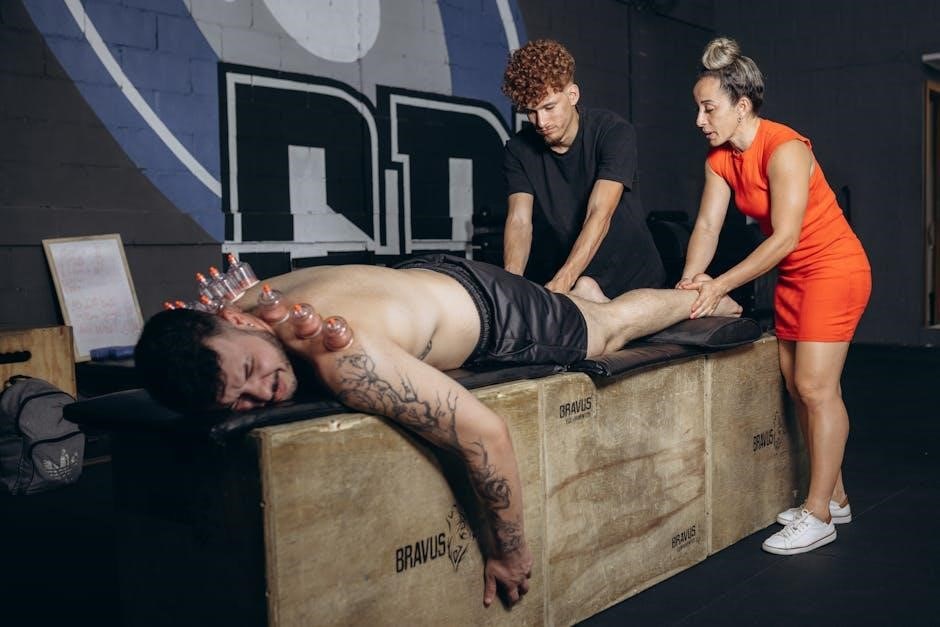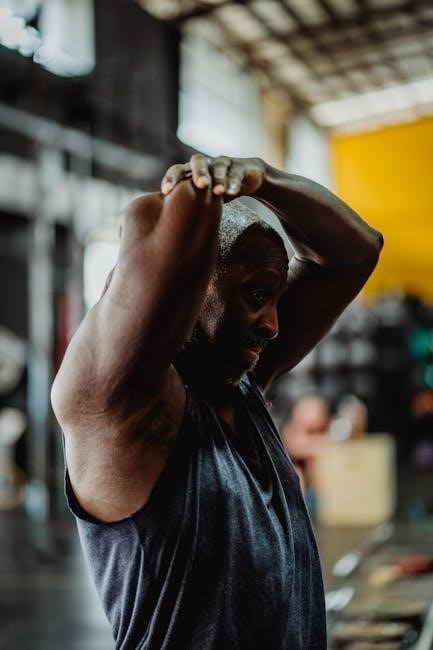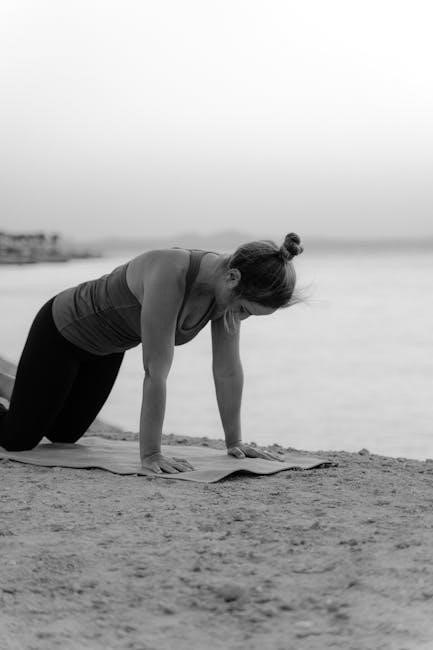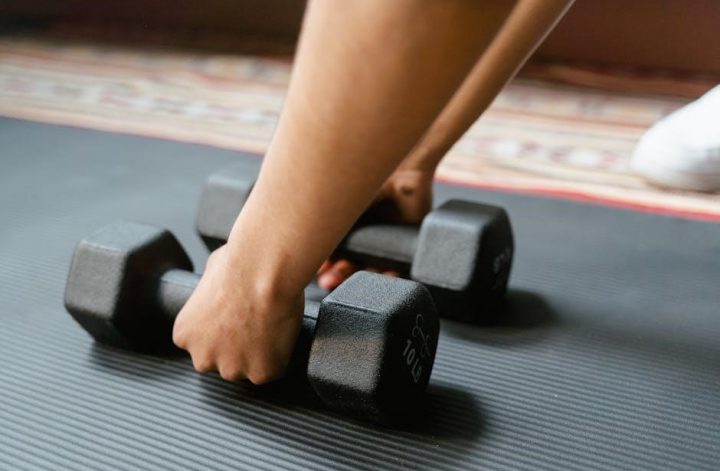Quadricep strengthening exercises are essential for improving knee function, stability, and overall lower body strength. These exercises target the four muscles of the quadriceps, enhancing athletic performance and reducing injury risk.
1.1 Importance of Strong Quadriceps for Knee Health and Athletic Performance
Strong quadriceps are vital for maintaining knee health and optimizing athletic performance. They provide stability to the knee joint, reduce injury risk, and enhance movement efficiency. For athletes, strong quads improve power, speed, and endurance, enabling better performance in activities like running, jumping, and cycling. Additionally, strengthening the quadriceps helps alleviate knee pain and stiffness, particularly in individuals with conditions like patellar tendinopathy. The quadriceps also play a crucial role in proper knee tracking and alignment, preventing issues such as patellofemoral pain syndrome. Thus, incorporating quad-strengthening exercises into a fitness routine is essential for both knee health and athletic success.
1.2 Overview of the Quadriceps Muscle Group and Its Functions
The quadriceps, or “quads,” are a group of four muscles in the anterior thigh: the rectus femoris, vastus lateralis, vastus medialis, and vastus intermedius. These muscles work together to straighten (extend) the knee and flex the hip. The quadriceps are essential for movements like walking, running, and climbing stairs. The vastus medialis obliquus (VMO) plays a key role in knee alignment and stability. Proper functioning of the quadriceps is crucial for maintaining balance, preventing injuries, and supporting overall lower body mobility. Strengthening these muscles enhances athletic performance and reduces the risk of knee-related injuries. Their coordinated action is vital for both everyday activities and sports.
Types of Quadricep Strengthening Exercises
Quadricep strengthening exercises include bodyweight movements like squats and lunges, isometric holds, and gym-based workouts such as leg extensions. Each targets different aspects of quad development for various fitness levels.

2.1 Bodyweight Exercises for Quad Strengthening
Bodyweight exercises are effective for strengthening the quadriceps without equipment. Squats, lunges, and planks target the quads while improving overall lower body stability. Step-ups and wall sits enhance endurance and muscle activation. These exercises are versatile, suitable for all fitness levels, and can be modified to increase difficulty. For example, single-leg squats challenge balance and strength. Bodyweight exercises are ideal for home workouts or when gym access is limited. They promote functional strength, improving daily activities and athletic performance. Incorporating these exercises into a routine helps build a strong foundation for more advanced training and supports long-term knee health. Consistency is key for optimal results.
2.2 Isometric and Eccentric Exercises for Rehabilitation
Isometric and eccentric exercises are crucial for rehabilitation, focusing on strengthening the quadriceps without joint movement. Isometric exercises, like quad sets, involve contracting the muscle without extending the knee, reducing strain. Eccentric exercises, such as controlled descents in squats or lunges, emphasize the lengthening phase, improving muscle resilience. These methods are ideal for individuals with knee pain or post-injury, as they minimize stress on the joint while promoting strength and stability. Progression is key, with gradual increases in intensity to avoid overloading the muscle. These exercises are often used in physical therapy to restore function and prevent further injury, ensuring a safe recovery process.
2.3 Gym-Based Exercises for Advanced Strength Training
Gym-based exercises offer advanced strength training for the quadriceps, utilizing equipment like leg presses, squats, and lunges. These exercises target the entire muscle group, enhancing power and endurance. Weighted squats and leg presses are effective for building bulk, while leg extensions isolate the quadriceps for focused development. Resistance bands and machines can also be incorporated to vary the workout. For athletes and individuals seeking intense muscle growth, gym-based exercises provide the necessary resistance and progression. Proper form is essential to avoid injury and maximize results, ensuring a safe and effective path to advanced quad strength; These exercises are ideal for those looking to push their limits.

Benefits of Quadricep Strengthening
Strengthening the quadriceps enhances knee stability, reduces pain, and improves physical function. It also boosts athletic performance and supports overall lower body strength, promoting better mobility and balance.
3.1 Reducing Knee Pain and Joint Stiffness
Strengthening the quadriceps significantly reduces knee pain and joint stiffness by improving muscle support around the knee joint; Stronger quads enhance stability, reducing strain on the knees during daily activities and sports. Isometric and eccentric exercises, such as straight-leg raises and leg extensions, are particularly effective for alleviating pain and improving joint mobility. Additionally, activities like cycling and aqua jogging promote blood flow and strengthen the surrounding muscles without putting excessive strain on the knees. Consistent practice of these exercises can lead to long-term relief from knee discomfort and improved functional movement.
3.2 Improving Physical Function and Athletic Performance
Strengthening the quadriceps enhances physical function and boosts athletic performance by improving power, speed, and endurance. Strong quads enable better hip and knee movement, crucial for activities like running, jumping, and cycling. Cross-training with exercises such as squats, lunges, and leg presses can further enhance lower body strength and coordination. For athletes, this translates to improved acceleration and agility, while for everyday individuals, it means easier performance of daily tasks. Consistent quadricep training also reduces fatigue during prolonged physical efforts, making it a cornerstone of both rehabilitation and performance enhancement programs.
3.4 Enhancing Muscle Balance and Overall Lower Body Strength
Strengthening the quadriceps helps restore muscle balance in the lower body, preventing imbalances that can lead to injuries. Weak quads can strain hamstrings and calves, while strong quads promote even strength distribution. This balance is vital for optimal movement and stability. Additionally, strong quadriceps contribute to overall lower body strength, enhancing activities like climbing stairs or carrying heavy objects. By incorporating exercises that target both quads and complementary muscles like hamstrings and glutes, individuals can achieve a well-rounded lower body strength profile, improving both functional ability and athletic performance.

Structuring a Quadricep Workout Plan
A well-structured quadricep workout plan includes a mix of bodyweight, resistance, and functional exercises. It should be tailored to individual goals, whether for rehabilitation or athletic performance. Progression and consistency are key to achieving strong, balanced quadriceps. Incorporating cross-training and varying intensity helps prevent plateaus and ensures comprehensive lower body development.
4.1 Creating a 6-Week Workout Program for Quad Development
A 6-week workout program for quad development should be structured to gradually increase intensity and volume. Start with foundational bodyweight exercises like squats and lunges, progressing to resistance-based movements such as leg presses and leg extensions. Incorporate isometric exercises for stability, such as wall sits, and eccentric exercises for strength, like controlled descents in squats. Split the program into phases: Weeks 1-2 focus on building endurance and basic strength, Weeks 3-4 introduce moderate resistance, and Weeks 5-6 emphasize advanced techniques and load. Ensure proper recovery and technique to maximize results and prevent injury.
4.2 Incorporating Cross-Training for Comprehensive Lower Body Development
Incorporating cross-training into your workout routine enhances quad strength while reducing overuse injuries. Activities like cycling, swimming, and aqua jogging provide low-impact alternatives that engage the quads without excessive strain. These exercises improve cardiovascular fitness and muscle balance, complementing traditional strength training. For example, stationary biking targets the quads and hamstrings, while swimming works multiple muscle groups simultaneously. Cross-training also allows for active recovery, maintaining progress without overloading the knees. By integrating these activities, you can diversify your routine, prevent plateaus, and achieve well-rounded lower body development. Start with 1-2 cross-training sessions per week and gradually increase based on tolerance and goals.

Progression and Safety in Quadricep Exercises
Progression involves gradually increasing resistance and reps. Safety requires proper technique, warm-ups, and monitoring pain. Avoid overloading to prevent injury and ensure recovery.
5.1 Avoiding Injury Through Proper Exercise Technique
Proper exercise technique is crucial for preventing injuries during quadricep strengthening. Start with controlled movements, maintaining alignment of the knees over toes. Avoid shifting weight or rounding the lower back. Engage your core to stabilize the body. Use full range of motion but stop if pain occurs. Gradually increase resistance to avoid muscle strain. Warm up before exercises to prepare muscles. Focus on slow eccentric phases to enhance strength and safety. Supervision by a trainer or therapist can help maintain form and reduce risk.
5.2 Managing Pain and Recovery During Strengthening Programs
Managing pain and recovery is vital during quadricep strengthening programs. Monitor pain levels, adjusting exercises to avoid aggravation. Use techniques like ice, stretching, and foam rolling to reduce muscle soreness. Incorporate rest days to allow muscle repair. Focus on progressive overload, gradually increasing intensity to avoid overstrain. Stay hydrated and maintain proper nutrition to support recovery. Listen to your body and modify exercises if pain persists. Consistent communication with trainers or therapists ensures safe progression and minimizes injury risk, promoting long-term strength and functionality.
Consistent practice and proper technique are key to achieving strong, healthy quadriceps. Prioritize recovery and gradual progression to maximize results and maintain long-term muscle strength and functionality.
6.1 The Role of Consistency in Achieving Stronger Quadriceps
Consistency is crucial for building stronger quadriceps. Regularly performing exercises like squats, lunges, and leg presses ensures progressive muscle development. Over time, this leads to improved strength, stability, and functionality.
6.2 Final Tips for Maximizing Quad Strengthening Results
To maximize quad strengthening results, incorporate a mix of bodyweight and resistance exercises, ensuring progressive overload. Include isometric holds for enhanced muscle activation and stability. Prioritize proper form to prevent injuries and optimize muscle engagement. Consistently challenge your quads with varied exercises, such as squats, lunges, and leg extensions. Adequate rest and recovery are vital for muscle growth and strength gains. Track your progress and adjust your workout plan accordingly. Stay motivated by setting achievable goals and celebrating milestones. Combining dedication with a well-structured routine will yield stronger, more resilient quadriceps over time.




